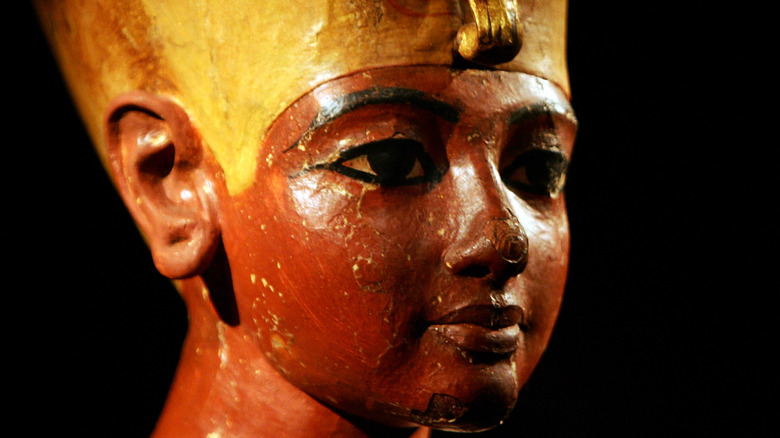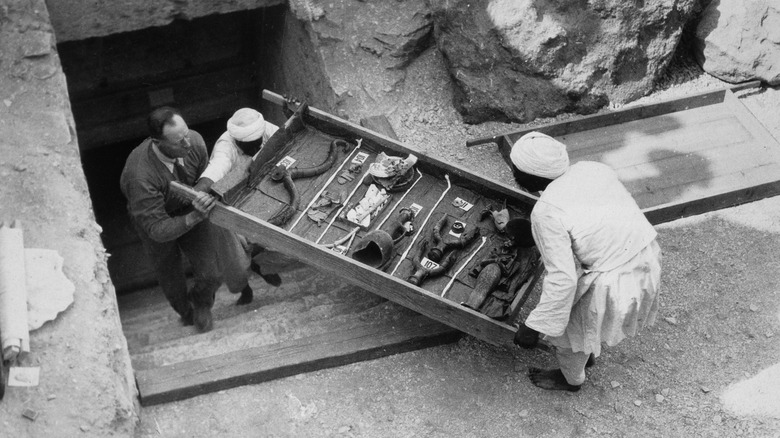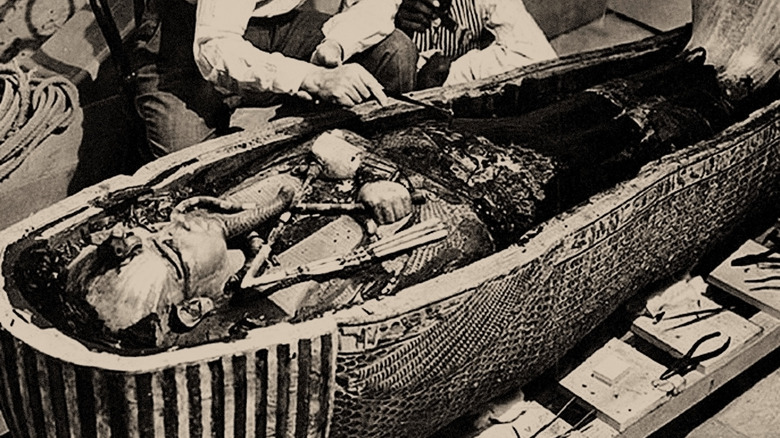King Tut's Body Wasn't Handled With Care, And Here's Proof
Today, King Tut (officially Tutankhamun) is one of the best-known Egyptian pharaohs, but also one of the most mysterious. The son of powerful and controversial Amenhotep IV, King Tut ascended to the throne after the death of his father. He was around 9 years old at the time (per Biography). A 9-year-old wasn't exactly ready to reign over a powerful civilization, so any political and military decisions were made by elders and military commanders. It's hard to guess how much "governing" King Tut did for the next 10 years, until his death circa 1323 B.C., and how many of his decisions were made by the people working behind the scenes — especially because Tutankhamun was apparently a very frail young boy.
According to National Geographic, King Tut likely suffered from a bone disorder, might have had a clubfoot, and it's probable he needed to use a cane. DNA tests conducted in 2010 also showed that King Tut had been infected with malaria several times during his short life — it's the oldest genetic proof of the disease found so far — and that he had suffered a serious fracture of his thighbone.
There's long been a debate on how King Tut died. A popular theory has always been that he was poisoned or murdered from a blow to the head, which could have explained why he was buried in a hurry and his body not handled with as much care as expected for a pharaoh. But other theories suggested he might have died from a blood infection or even an accident (via National Geographic).
A burial not fit for a king
When English archaeologist Howard Carter uncovered the tomb of King Tut in 1922, little was known about the "boy king." Archaeologists at the time didn't have the proper technology to figure out what had happened to the young pharaoh, but it was clear from the beginning that his tomb didn't look like other royal tombs (per BBC News).
According to another National Geographic post, King Tut's tomb is small and lacks the splendor you would expect for somebody his status. It's likely that's because Tut died young and unexpectedly, so there was no tomb ready for him. Instead, he was probably buried in a rush, using a tomb that was meant for somebody else. For some time, experts even thought maybe the tomb contained a secret chamber — that it only looked small but really wasn't. But scans and research didn't reveal anything else. It seems as though King Tut's rushed burial really had landed him in a tiny tomb because nothing else was available.
Another sign of how quickly the king was buried is the many brown spots found on the walls and over the mural paintings. Only recently have scientists figured out that the spots are a result of fungi and bacteria byproducts caused by a too-rushed plastering and painting job, indicating that the tomb was sealed before the walls had a chance to completely dry (via National Geographic). Which brings us to the next step: Tut was also embalmed in a rush.
Here's how King Tut died (maybe)
For years, scientists had known that King Tut had a broken leg, but there was no definitive theory as to how or when that injury had occurred (per National Geographic). But in 2013, scientists from the Cranfield Forensic Institute in the U.K. were able to perform a "virtual autopsy" of Tutankhamun's body to analyze his injuries. Turned out the young pharaoh had more than just a broken leg (per Forbes). Researchers also found many other injuries, including smashed ribs, a shattered pelvis, and crushed internal organs — the type of catastrophic injuries one would receive during a car crash. Or, in pharaoh's times, a chariot crash (per NBC News).
This could have happened when a chariot crashed into him (though experts believe he would have had to be on his knees for the type of injuries received). Or it could be the result of a chariot crashing as the king was riding in it (per National Geographic). Either way, his death was unexpected and likely quick, which would also explain why he was buried in a hurry and why there wasn't already a tomb built for his eternal rest.
It also explains another great mystery: Why did Howard Carter's notes from 1922 state that the body seemed to show signs of burning? And could there actually be a plausible explanation for the burn marks? According to archaeologists who examined samples of King Tut's flesh and bones under a microscope in 2013, the mummy did show signs of having been on fire, which led to an even bigger question, as reported via BBC News.
How does a mummy catch fire in an underground tomb?
Back in ancient Egypt, embalming was not a quick and easy job. According to Discover Magazine, it would take a group of priests (the official royal embalmers of the time) about 70 days to get through the mummification procedure that would prepare a body for the afterlife. Steps in the process included removal of the organs, using certain oils and spices, covering the body with natron (a type of salt) to dry up the skin, and more. The result would've been a completely dry body that could be preserved for thousands of years.
But since King Tut's body was buried in a hurry, experts now believe the mummification process might have been rushed, too. Because of that, the oils were not allowed enough time to dry up and instead ended up soaking into the linen used to wrap the body. After the burial, this ended up causing a reaction that started a fire, essentially "cooking" the body at temperatures close to 400 degrees Fahrenheit (per NBC News). According to The Guardian Liberty Voice, this would also explain why no heart was found inside the body: The fire would have completely destroyed it.
Although an extremely rare occurrence, this would have never happened during the proper mummification process of a pharaoh. But a quick burial likely resulted in less care to preserve the body, or possibly just not waiting enough time between steps.


